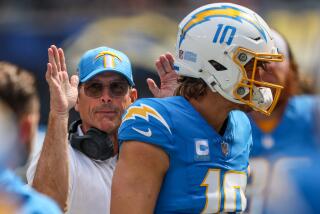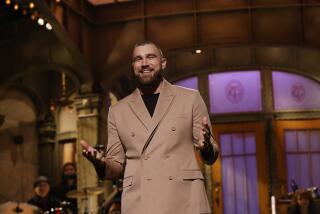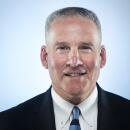The quarterback guruâs magic touch
The vanity license plate is hard to miss as the black BMW sport-utility vehicle pulls into a parking spot outside a middle school in San Marino.
QB CLUB.
From behind the wheel steps a man dressed in shorts, a T-shirt and ball cap, all black. From the passenger side emerges a teenage boy, tall and slender, wearing a white T-shirt, black shorts, cleats â and clutching a football.
The two walk determinedly past an expansive grass field and head toward the playground.
The young quarterback drops the ball, and then grips the post of a chin-up bar and stretches his right arm. As the man barks instruction about the fundamentals of throwing a pass, it is clear they are there for more than a simple game of catch.
The man grabs a large plastic trash bin, steps to within a few feet of the teenager, and hoists the receptacle onto his shoulder with the open end next to his right ear.
âThrow it,â he commands, âright down the barrel.â
Boom!
The ball ricochets off the bottom of the bin in staccato blasts.
Boom! Boom! Boom!
The man laughs. The boy keeps firing away.
In an era of specialized sports training that includes high-tech gizmos, computerized feedback and virtual-reality scenarios, is this any way to develop a Heisman Trophy winner or professional football star?
Apparently it is.
(break)
In December, when USCâs junior quarterback Matt Barkley was pondering whether to leave the school and turn pro, pundits and fans speculated about who might take over the Trojansâ offense.
One thing was clear: Steve Clarkson was likely to figure in the succession.
Clarkson, the man with the trash can, is a private quarterback coach. He had a hand in developing Matt Leinart and Barkley, two of the last four starting quarterbacks at USC. Two of his protĂŠgĂŠs, including the boy on the playground, could be next in line.
The vast majority of drills Clarkson uses are variations of basic footwork and throwing concepts taught by many coaches. But the high-priced tutor â he says he is paid as much as $600 an hour for private lessons â is not afraid to introduce low-tech equipment to emphasize a point about proper mechanics.
âYouâre always looking for new ways to teach fundamentals,â he says. âSometimes the simplest method is the best.â
Hence the trash can, a prop Clarkson started to use in training regimens about a year ago. Borrowing principles of focus and movement from tai chi, he aims to make quarterbacks simulate distance by hitting the âeyeballâ at the bottom of the bin.
The drill also allows Clarkson a close look at every aspect of the passerâs delivery.
David Sills, a 15-year-old high school freshman from Delaware, has grown accustomed to Clarksonâs unconventional ways. So he doesnât flinch when instructed to imagine a scenario unfolding inside the garbage can.
âLook at the target,â Clarkson says, âlike youâre throwing a dig route downfield.â
Sills hesitates for a moment, laughs, then begins his barrage of passes into the barrel.
âI donât know where he learned it, but he knows whatâs wrong with it and knows how to correct it,â he says of Clarksonâs ability to help with his throwing mechanics. âI guess thatâs the magic touch.â
Barkley says Clarkson focuses on details such as arm angle, hand and foot position and recognizing defenses. Emphasis also is placed on making what Clarkson describes as âthe imperfect perfect throwâ â when quarterbacks must execute under duress in game conditions.
âPeople think itâs âdrop back and throw the ball,ââ says Barkley, who now works out exclusively with USC coaches, âbut thereâs so much that goes into just making it spiral.â
(break)
Clarkson, 50, did not set out to be a coach. Growing up in the Lincoln Heights area of Los Angeles, he was intent on becoming an NFL quarterback, a dream born after watching Roman Gabriel of the Rams and Joe Kapp of the Minnesota Vikings duel in a 1969 game at the Coliseum.
At Wilson High, he learned in an innovative, freewheeling system under legendary offensive coach Vic Cuccia. âHe gave us the concepts, and we literally made up plays in the huddle,â Clarkson says.
Clarkson had a record-setting career at San Jose State, where his coach was Jack Elway, father of Hall of Fame quarterback John Elway.
Clarkson attended training camp with the Denver Broncos but never played in the NFL during an era when black quarterbacks were a rarity. He played briefly in the Canadian Football League.
âIf I were coming out of college right now, it would be a different story,â he says. âIâve moved on. It was a sign of the times, and Iâm doing what Iâm supposed to be doing.â
Clarkson fell into coaching in the mid-1980s after answering a newspaper advertisement seeking a youth football coach. He later became an assistant at Palisades and Carson high schools, mentoring record-setting quarterbacks while gaining a reputation for stirring up controversy by orchestrating transfers.
The publicity â positive and negative â boosted Clarksonâs career. Then Leinartâs success generated a national buzz.
Now, Clarkson is perhaps the most sought-after private coach among dozens who advertise their services as a means for a player to earn a college football scholarship and maybe a lucrative NFL contract. Today, Clarkson says he has about 50 clients, the majority paying about $7,500 for year-round group instruction.
Pro football Hall of Famer Joe Montana and former NHL great Wayne Gretzky entrusted the development of their sons to Clarkson. So has former NFL coach Jack Del Rio.
âI have one of those kinds of niche professions,â Clarkson says, âwhere even when the economy is bad, people will sort of roll the dice.â
Leinart was a 14-year-old high school freshman in 1997 when his coaches at Mater Dei in Santa Ana put him in contact with Clarkson. Nine years later, he was a Heisman Trophy winner and a two-time All-American when he was drafted out of USC by the Arizona Cardinals. He signed a contract for a guaranteed $14 million.
Leinart says Clarkson did not hammer on one specific element of quarterback play. Instead, he covered a gamut of skills and scenarios.
âThere are coaches that pioneered some of the basic drills, but Steve evolved them, and he pushed you to the limit,â says Leinart, who played last season with the Houston Texans. âYou learned through repetition, and you had to be able to take criticism.â
Clarkson also worked with Matt Cassel, who played behind Leinart at USC. Cassel was a reserve for the New England Patriots before signing a contract with the Kansas City Chiefs that guarantees him $28 million.
Clarkson was hired to help prepare Pittsburgh Steelers quarterback Ben Roethlisberger for the 2004 draft, and he tutored Carolina Panthers quarterback Jimmy Clausen from grade school through high school.
Barkley, who decided to stay at USC for his senior year, and Max Wittek, a redshirt freshman with the Trojans, both trained with Clarkson before college. Barkley is expected to be among the early picks in the 2013 NFL draft; Wittek could become USCâs starter after Barkley graduates.
Then there is Sills, the kid in the playground beating up the bottom of that trash can.
(break)
Sillsâ father, David IV, contacted Clarkson five years ago after reading a newspaper story about the coachâs success with Clausen.
Young David was in seventh grade when he received a scholarship offer from USC shortly after Clarkson suggested that Coach Lane Kiffin check out a video of the teenager. Sills is still three years from becoming a Trojan.
Once a month he travels across the country from Delaware for three days of private and group instruction. He stays with Clarkson and his wife and two young sons at their San Gabriel home. Clarkson has two sons from a previous marriage, including Anton, 28, who also coaches quarterbacks.
Early on the second day of Sillsâ December visit, the quarterback and his coach are on a field at Venice High; the grass is strewn with white sea gull feathers, lending the appearance of a fluffy white blanket.
Sills and Clarkson are at one end, and at the other is a group of quarterbacks and receivers working with coaches Clarkson employs part time.
With Clarkson stationed a few feet in front of him, Sills stands in a throwing position, his right arm cocked with the ball next to his right ear.
âStep,â Clarkson says, and Sills moves his left foot forward and begins his throwing motion.
âBam!âClarkson says, reaching toward the ball. âHold that spot.â Sills freezes. Clarkson slowly circles and takes in all angles.
âReset,â Clarkson says. Sills repeats the drill until the coach is satisfied and then finishes the workout by throwing passes to receivers.
The next day, Clarkson and Sills go to Cathedral High near downtown Los Angeles to join more than two dozen quarterbacks from all over Southern California for a weekly 90-minute session supervised by Clarkson and his associates.
Fathers watch attentively from the sideline.
Reginald Bell Sr. says Clarkson helped make the program affordable so he could enroll his son, who plays quarterback at Dorsey High in Los Angeles.
âItâs an investment,â Bell says. âIf he can get a free education, itâs definitely worth it.â
But what if their sons donât become the next Leinart or Barkley?
âI certainly wonât have any disappointment or anything like that because heâs enjoying the hell out of what heâs doing now,â says Deron White, whose son, Brady, plays at Hart High in Newhall.
During football season, Clarkson says, he spends about 10 hours a week watching high school, college and pro games. He checks his pupilsâ mechanics and evaluates their demeanor on the field and on the sideline.
None is a finished product, so he continues to tinker.
And all the while, he keeps searching for the next great quarterback.
More to Read
Go beyond the scoreboard
Get the latest on L.A.'s teams in the daily Sports Report newsletter.
You may occasionally receive promotional content from the Los Angeles Times.







